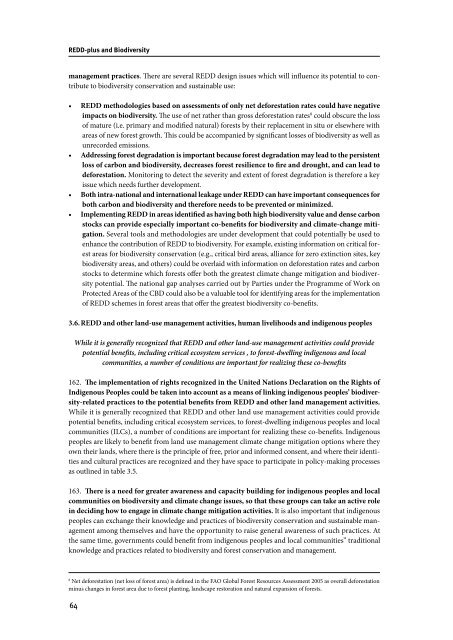REDD-plus and Biodiversity - Convention on Biological Diversity
REDD-plus and Biodiversity - Convention on Biological Diversity
REDD-plus and Biodiversity - Convention on Biological Diversity
You also want an ePaper? Increase the reach of your titles
YUMPU automatically turns print PDFs into web optimized ePapers that Google loves.
<str<strong>on</strong>g>REDD</str<strong>on</strong>g>-<str<strong>on</strong>g>plus</str<strong>on</strong>g> <str<strong>on</strong>g>and</str<strong>on</strong>g> <str<strong>on</strong>g>Biodiversity</str<strong>on</strong>g><br />
management practices. There are several <str<strong>on</strong>g>REDD</str<strong>on</strong>g> design issues which will influence its potential to c<strong>on</strong>tribute<br />
to biodiversity c<strong>on</strong>servati<strong>on</strong> <str<strong>on</strong>g>and</str<strong>on</strong>g> sustainable use:<br />
• <str<strong>on</strong>g>REDD</str<strong>on</strong>g> methodologies based <strong>on</strong> assessments of <strong>on</strong>ly net deforestati<strong>on</strong> rates could have negative<br />
impacts <strong>on</strong> biodiversity. The use of net rather than gross deforestati<strong>on</strong> rates 8 could obscure the loss<br />
of mature (i.e. primary <str<strong>on</strong>g>and</str<strong>on</strong>g> modified natural) forests by their replacement in situ or elsewhere with<br />
areas of new forest growth. This could be accompanied by significant losses of biodiversity as well as<br />
unrecorded emissi<strong>on</strong>s.<br />
• Addressing forest degradati<strong>on</strong> is important because forest degradati<strong>on</strong> may lead to the persistent<br />
loss of carb<strong>on</strong> <str<strong>on</strong>g>and</str<strong>on</strong>g> biodiversity, decreases forest resilience to fire <str<strong>on</strong>g>and</str<strong>on</strong>g> drought, <str<strong>on</strong>g>and</str<strong>on</strong>g> can lead to<br />
deforestati<strong>on</strong>. M<strong>on</strong>itoring to detect the severity <str<strong>on</strong>g>and</str<strong>on</strong>g> extent of forest degradati<strong>on</strong> is therefore a key<br />
issue which needs further development.<br />
• Both intra-nati<strong>on</strong>al <str<strong>on</strong>g>and</str<strong>on</strong>g> internati<strong>on</strong>al leakage under <str<strong>on</strong>g>REDD</str<strong>on</strong>g> can have important c<strong>on</strong>sequences for<br />
both carb<strong>on</strong> <str<strong>on</strong>g>and</str<strong>on</strong>g> biodiversity <str<strong>on</strong>g>and</str<strong>on</strong>g> therefore needs to be prevented or minimized.<br />
• Implementing <str<strong>on</strong>g>REDD</str<strong>on</strong>g> in areas identified as having both high biodiversity value <str<strong>on</strong>g>and</str<strong>on</strong>g> dense carb<strong>on</strong><br />
stocks can provide especially important co-benefits for biodiversity <str<strong>on</strong>g>and</str<strong>on</strong>g> climate-change mitigati<strong>on</strong>.<br />
Several tools <str<strong>on</strong>g>and</str<strong>on</strong>g> methodologies are under development that could potentially be used to<br />
enhance the c<strong>on</strong>tributi<strong>on</strong> of <str<strong>on</strong>g>REDD</str<strong>on</strong>g> to biodiversity. For example, existing informati<strong>on</strong> <strong>on</strong> critical forest<br />
areas for biodiversity c<strong>on</strong>servati<strong>on</strong> (e.g., critical bird areas, alliance for zero extincti<strong>on</strong> sites, key<br />
biodiversity areas, <str<strong>on</strong>g>and</str<strong>on</strong>g> others) could be overlaid with informati<strong>on</strong> <strong>on</strong> deforestati<strong>on</strong> rates <str<strong>on</strong>g>and</str<strong>on</strong>g> carb<strong>on</strong><br />
stocks to determine which forests offer both the greatest climate change mitigati<strong>on</strong> <str<strong>on</strong>g>and</str<strong>on</strong>g> biodiversity<br />
potential. The nati<strong>on</strong>al gap analyses carried out by Parties under the Programme of Work <strong>on</strong><br />
Protected Areas of the CBD could also be a valuable tool for identifying areas for the implementati<strong>on</strong><br />
of <str<strong>on</strong>g>REDD</str<strong>on</strong>g> schemes in forest areas that offer the greatest biodiversity co-benefits.<br />
3.6. <str<strong>on</strong>g>REDD</str<strong>on</strong>g> <str<strong>on</strong>g>and</str<strong>on</strong>g> other l<str<strong>on</strong>g>and</str<strong>on</strong>g>-use management activities, human livelihoods <str<strong>on</strong>g>and</str<strong>on</strong>g> indigenous peoples<br />
While it is generally recognized that <str<strong>on</strong>g>REDD</str<strong>on</strong>g> <str<strong>on</strong>g>and</str<strong>on</strong>g> other l<str<strong>on</strong>g>and</str<strong>on</strong>g>-use management activities could provide<br />
potential benefits, including critical ecosystem services , to forest-dwelling indigenous <str<strong>on</strong>g>and</str<strong>on</strong>g> local<br />
communities, a number of c<strong>on</strong>diti<strong>on</strong>s are important for realizing these co-benefits<br />
162. The implementati<strong>on</strong> of rights recognized in the United Nati<strong>on</strong>s Declarati<strong>on</strong> <strong>on</strong> the Rights of<br />
Indigenous Peoples could be taken into account as a means of linking indigenous peoples’ biodiversity-related<br />
practices to the potential benefits from <str<strong>on</strong>g>REDD</str<strong>on</strong>g> <str<strong>on</strong>g>and</str<strong>on</strong>g> other l<str<strong>on</strong>g>and</str<strong>on</strong>g> management activities.<br />
While it is generally recognized that <str<strong>on</strong>g>REDD</str<strong>on</strong>g> <str<strong>on</strong>g>and</str<strong>on</strong>g> other l<str<strong>on</strong>g>and</str<strong>on</strong>g> use management activities could provide<br />
potential benefits, including critical ecosystem services, to forest-dwelling indigenous peoples <str<strong>on</strong>g>and</str<strong>on</strong>g> local<br />
communities (ILCs), a number of c<strong>on</strong>diti<strong>on</strong>s are important for realizing these co-benefits. Indigenous<br />
peoples are likely to benefit from l<str<strong>on</strong>g>and</str<strong>on</strong>g> use management climate change mitigati<strong>on</strong> opti<strong>on</strong>s where they<br />
own their l<str<strong>on</strong>g>and</str<strong>on</strong>g>s, where there is the principle of free, prior <str<strong>on</strong>g>and</str<strong>on</strong>g> informed c<strong>on</strong>sent, <str<strong>on</strong>g>and</str<strong>on</strong>g> where their identities<br />
<str<strong>on</strong>g>and</str<strong>on</strong>g> cultural practices are recognized <str<strong>on</strong>g>and</str<strong>on</strong>g> they have space to participate in policy-making processes<br />
as outlined in table 3.5.<br />
163. There is a need for greater awareness <str<strong>on</strong>g>and</str<strong>on</strong>g> capacity building for indigenous peoples <str<strong>on</strong>g>and</str<strong>on</strong>g> local<br />
communities <strong>on</strong> biodiversity <str<strong>on</strong>g>and</str<strong>on</strong>g> climate change issues, so that these groups can take an active role<br />
in deciding how to engage in climate change mitigati<strong>on</strong> activities. It is also important that indigenous<br />
peoples can exchange their knowledge <str<strong>on</strong>g>and</str<strong>on</strong>g> practices of biodiversity c<strong>on</strong>servati<strong>on</strong> <str<strong>on</strong>g>and</str<strong>on</strong>g> sustainable management<br />
am<strong>on</strong>g themselves <str<strong>on</strong>g>and</str<strong>on</strong>g> have the opportunity to raise general awareness of such practices. At<br />
the same time, governments could benefit from indigenous peoples <str<strong>on</strong>g>and</str<strong>on</strong>g> local communities” traditi<strong>on</strong>al<br />
knowledge <str<strong>on</strong>g>and</str<strong>on</strong>g> practices related to biodiversity <str<strong>on</strong>g>and</str<strong>on</strong>g> forest c<strong>on</strong>servati<strong>on</strong> <str<strong>on</strong>g>and</str<strong>on</strong>g> management.<br />
8<br />
Net deforestati<strong>on</strong> (net loss of forest area) is defined in the FAO Global Forest Resources Assessment 2005 as overall deforestati<strong>on</strong><br />
minus changes in forest area due to forest planting, l<str<strong>on</strong>g>and</str<strong>on</strong>g>scape restorati<strong>on</strong> <str<strong>on</strong>g>and</str<strong>on</strong>g> natural expansi<strong>on</strong> of forests.<br />
64

















